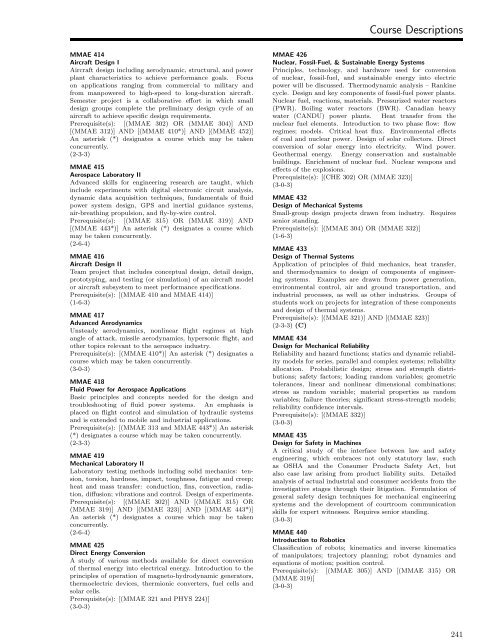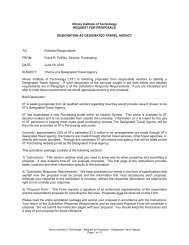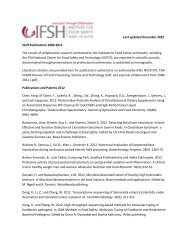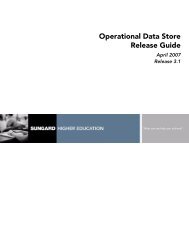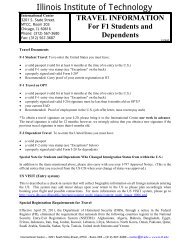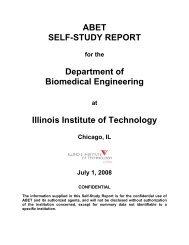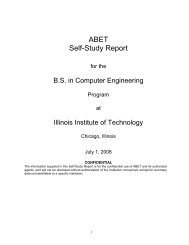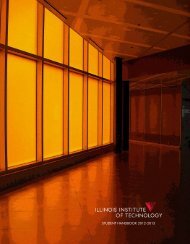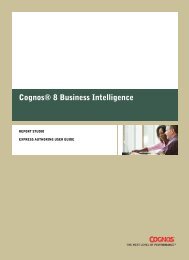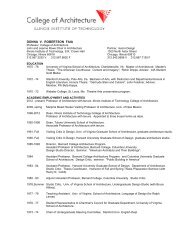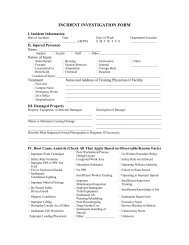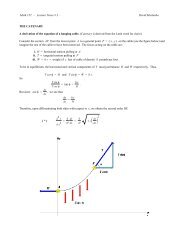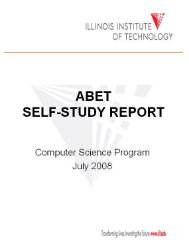Undergraduate Bulletin - Illinois Institute of Technology
Undergraduate Bulletin - Illinois Institute of Technology
Undergraduate Bulletin - Illinois Institute of Technology
You also want an ePaper? Increase the reach of your titles
YUMPU automatically turns print PDFs into web optimized ePapers that Google loves.
Course Descriptions<br />
MMAE 414<br />
Aircraft Design I<br />
Aircraft design including aerodynamic, structural, and power<br />
plant characteristics to achieve performance goals. Focus<br />
on applications ranging from commercial to military and<br />
from manpowered to high-speed to long-duration aircraft.<br />
Semester project is a collaborative effort in which small<br />
design groups complete the preliminary design cycle <strong>of</strong> an<br />
aircraft to achieve specific design requirements.<br />
Prerequisite(s): [(MMAE 302) OR (MMAE 304)] AND<br />
[(MMAE 312)] AND [(MMAE 410*)] AND [(MMAE 452)]<br />
An asterisk (*) designates a course which may be taken<br />
concurrently.<br />
(2-3-3)<br />
MMAE 415<br />
Aerospace Laboratory II<br />
Advanced skills for engineering research are taught, which<br />
include experiments with digital electronic circuit analysis,<br />
dynamic data acquisition techniques, fundamentals <strong>of</strong> fluid<br />
power system design, GPS and inertial guidance systems,<br />
air-breathing propulsion, and fly-by-wire control.<br />
Prerequisite(s): [(MMAE 315) OR (MMAE 319)] AND<br />
[(MMAE 443*)] An asterisk (*) designates a course which<br />
may be taken concurrently.<br />
(2-6-4)<br />
MMAE 416<br />
Aircraft Design II<br />
Team project that includes conceptual design, detail design,<br />
prototyping, and testing (or simulation) <strong>of</strong> an aircraft model<br />
or aircraft subsystem to meet performance specifications.<br />
Prerequisite(s): [(MMAE 410 and MMAE 414)]<br />
(1-6-3)<br />
MMAE 417<br />
Advanced Aerodynamics<br />
Unsteady aerodynamics, nonlinear flight regimes at high<br />
angle <strong>of</strong> attack, missile aerodynamics, hypersonic flight, and<br />
other topics relevant to the aerospace industry.<br />
Prerequisite(s): [(MMAE 410*)] An asterisk (*) designates a<br />
course which may be taken concurrently.<br />
(3-0-3)<br />
MMAE 418<br />
Fluid Power for Aerospace Applications<br />
Basic principles and concepts needed for the design and<br />
troubleshooting <strong>of</strong> fluid power systems. An emphasis is<br />
placed on flight control and simulation <strong>of</strong> hydraulic systems<br />
and is extended to mobile and industrial applications.<br />
Prerequisite(s): [(MMAE 313 and MMAE 443*)] An asterisk<br />
(*) designates a course which may be taken concurrently.<br />
(2-3-3)<br />
MMAE 419<br />
Mechanical Laboratory II<br />
Laboratory testing methods including solid mechanics: tension,<br />
torsion, hardness, impact, toughness, fatigue and creep;<br />
heat and mass transfer: conduction, fins, convection, radiation,<br />
diffusion; vibrations and control. Design <strong>of</strong> experiments.<br />
Prerequisite(s): [(MMAE 302)] AND [(MMAE 315) OR<br />
(MMAE 319)] AND [(MMAE 323)] AND [(MMAE 443*)]<br />
An asterisk (*) designates a course which may be taken<br />
concurrently.<br />
(2-6-4)<br />
MMAE 425<br />
Direct Energy Conversion<br />
A study <strong>of</strong> various methods available for direct conversion<br />
<strong>of</strong> thermal energy into electrical energy. Introduction to the<br />
principles <strong>of</strong> operation <strong>of</strong> magneto-hydrodynamic generators,<br />
thermoelectric devices, thermionic converters, fuel cells and<br />
solar cells.<br />
Prerequisite(s): [(MMAE 321 and PHYS 224)]<br />
(3-0-3)<br />
MMAE 426<br />
Nuclear, Fossil-Fuel, & Sustainable Energy Systems<br />
Principles, technology, and hardware used for conversion<br />
<strong>of</strong> nuclear, fossil-fuel, and sustainable energy into electric<br />
power will be discussed. Thermodynamic analysis – Rankine<br />
cycle. Design and key components <strong>of</strong> fossil-fuel power plants.<br />
Nuclear fuel, reactions, materials. Pressurized water reactors<br />
(PWR). Boiling water reactors (BWR). Canadian heavy<br />
water (CANDU) power plants. Heat transfer from the<br />
nuclear fuel elements. Introduction to two phase flow: flow<br />
regimes; models. Critical heat flux. Environmental effects<br />
<strong>of</strong> coal and nuclear power. Design <strong>of</strong> solar collectors. Direct<br />
conversion <strong>of</strong> solar energy into electricity. Wind power.<br />
Geothermal energy. Energy conservation and sustainable<br />
buildings. Enrichment <strong>of</strong> nuclear fuel. Nuclear weapons and<br />
effects <strong>of</strong> the explosions.<br />
Prerequisite(s): [(CHE 302) OR (MMAE 323)]<br />
(3-0-3)<br />
MMAE 432<br />
Design <strong>of</strong> Mechanical Systems<br />
Small-group design projects drawn from industry.<br />
senior standing.<br />
Prerequisite(s): [(MMAE 304) OR (MMAE 332)]<br />
(1-6-3)<br />
Requires<br />
MMAE 433<br />
Design <strong>of</strong> Thermal Systems<br />
Application <strong>of</strong> principles <strong>of</strong> fluid mechanics, heat transfer,<br />
and thermodynamics to design <strong>of</strong> components <strong>of</strong> engineering<br />
systems. Examples are drawn from power generation,<br />
environmental control, air and ground transportation, and<br />
industrial processes, as well as other industries. Groups <strong>of</strong><br />
students work on projects for integration <strong>of</strong> these components<br />
and design <strong>of</strong> thermal systems.<br />
Prerequisite(s): [(MMAE 321)] AND [(MMAE 323)]<br />
(2-3-3) (C)<br />
MMAE 434<br />
Design for Mechanical Reliability<br />
Reliability and hazard functions; statics and dynamic reliability<br />
models for series, parallel and complex systems; reliability<br />
allocation. Probabilistic design; stress and strength distributions;<br />
safety factors; loading random variables; geometric<br />
tolerances, linear and nonlinear dimensional combinations;<br />
stress as random variable; material properties as random<br />
variables; failure theories; significant stress-strength models;<br />
reliability confidence intervals.<br />
Prerequisite(s): [(MMAE 332)]<br />
(3-0-3)<br />
MMAE 435<br />
Design for Safety in Machines<br />
A critical study <strong>of</strong> the interface between law and safety<br />
engineering, which embraces not only statutory law, such<br />
as OSHA and the Consumer Products Safety Act, but<br />
also case law arising from product liability suits. Detailed<br />
analysis <strong>of</strong> actual industrial and consumer accidents from the<br />
investigative stages through their litigation. Formulation <strong>of</strong><br />
general safety design techniques for mechanical engineering<br />
systems and the development <strong>of</strong> courtroom communication<br />
skills for expert witnesses. Requires senior standing.<br />
(3-0-3)<br />
MMAE 440<br />
Introduction to Robotics<br />
Classification <strong>of</strong> robots; kinematics and inverse kinematics<br />
<strong>of</strong> manipulators; trajectory planning; robot dynamics and<br />
equations <strong>of</strong> motion; position control.<br />
Prerequisite(s): [(MMAE 305)] AND [(MMAE 315) OR<br />
(MMAE 319)]<br />
(3-0-3)<br />
241


